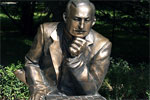


ChessBase 17 - Mega package - Edition 2024
It is the program of choice for anyone who loves the game and wants to know more about it. Start your personal success story with ChessBase and enjoy the game even more.
Report by Piotr Kaim / Photos by Sylwia Rudolf

Musical fountain in the town of Polanica-Zdroj
The Polanica-Zdroj Chess Festival started in 1963, and has been organized as the Akiba Rubinstein Memorial since 1965. The Memorial's round robin tournaments have earned a reputation as strong events where aspiring masters (most often Polish ones) compete with world class GMs. As far as the latter group is concerned, Polanica used to attract really big names including Vassily Smyslov, Salomon Flohr, Yuri Averbakh, Vlastimil Hort, Wolfgang Uhlmann, Ulf Andersson, Boris Gulko and many others.
The Festival's golden era came with the last decade of the 20th century when the round-robin tournaments involved players like Vesselin Topalov, Viktor Korchnoi, Sergey Dolmatov, Oleg Romanishin, Alexander Beliavsky, Jaan Ehlvest, Joel Lautier and Susan Polgar. The strongest and the most memorable tournament was held in 1998 when Anatoly Karpov (the then FIDE World Champion) finished miserably at 4/9 after losing to Michal Krasenkow and Sergei Rublevsky; the tournament was dominated by Boris Gelfand followed by Alexei Shirov and a group of four top GMs including Michal Krasenkow, Vassily Ivanchuk, Peter Leko and Sergei Rublevsky.
Unfortunately, after the onset of the 21st century, the Memorial's rank collapsed due to financial problems, and there were years with no chess festival at all, while in others there was no GM round robin tournament. Recently, the organizers have worked hard to re-establish the Rubinstein Memorial to it former glory and the GM round-robin has come back. Its 2011 strength (2441 average ranking) was rather modest, but the tournament is likely to develop in the near future.
Big hopes are associated with the year 2012, a very special one for the Memorial as it marks a centennial of the patron's greatest achievements. In 1912, Akiba Rubinstein won five top tournaments in a succession (including San Sebastian), and was considered the outright favorite to play Emanuel Lasker for the world championship. That is why the European Chess Union declared 2012 as the year of the great Jewish-Polish grandmaster. The Memorial organizers expect these coinciding circumstances will help them to attract sponsors for the 2012 event.
Their success would be a good news for chess players given the beauty of Polanica and its surroundings. Should you need evidence on these issues, please take a photo tour at the end of this report. Please also note that the Rubinstein Memorial is not limited to ten players competing in the GM round-robin. There is also an open tournament (for players of at least 1700 Elo), a tournament for players ranked up to 2000, a senior tournament (men aged at least 60 and women aged at least 50), two tournaments for children aged under ten and under fourteen, and an assortment of rapid and blitz tournaments. On top of this you can also participate in a Fischer Random chess tournament and a solving contest.

IM Hnydiuk is bored with his winning chess
This year, the GM round-robin was won by a Polish IM Aleksander Hnydiuk (2432) who scored his first GM norm with 6.5/9 and a 2608 performance. He left behind a group of three players who scored 5.5/9 including IM Marcin Tazbir (2520), IM Marcin Sieciechowicz (2454) and FM Mateusz Kolosowski (2408). The biggest name in the field was GM Vladimir Malaniuk (2455), who had been a three-time Ukraine Champion and a regular participant of the Soviet Championship Finals. Unfortunately, this time he limited his efforts to quick draws and outplaying the lowest-ranked Pawel Stoma (2322), which gave him five points and a 5th/6th place shared with GM Vadim Shishkin (2457).
When I approached Aleksander Hnydiuk, the tournament winner, he declared he plays "boring chess". – "I have nothing to show to the Chessbase readers" – he added. Only after I insisted that he should reconsider, did the winner recall a quality game against GM Vadim Shishkin.


IM Tazbir (2520) finished second, but failed to score a GM norm

IM Sieciechowicz surprised by a photographer while noting down a move from GM Shishkin

GM Malaniuk confirms a common perception: the neighbours’
position is always more interesting than our own.

FM Bartosz Kocwin of the open tournament: the best painter
among chess players and vice versa.

The River Bystrzyca Dusznicka (try to pronounce it!) flowing
through Polanica-Zdroj.

This fellow is supposed to resemble Akiba Rubinstein; does he?

Stonewall Defence: that’s where the idea was born...

... but it was a poor choice against Akiba Rubinstein: he used to look at details and
could always find the holes.

Anthropoid: another evidence for the theory of evolution

“It’s really difficult to see the sunlight unless you are in a cave”
(quote by Plato, Rudolf & Kaim)

Rubinstein’s rook endings inspired Mother Nature

Warning: keep your hands off that little top stone!
LinksThe games will be broadcast live on the official web site and on the chess server Playchess.com. If you are not a member you can download a free Playchess client there and get immediate access. You can also use ChessBase 11 or any of our Fritz compatible chess programs. |
 |